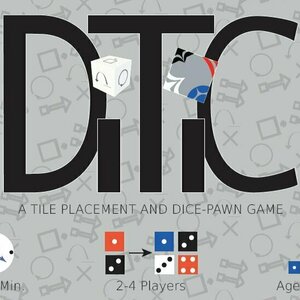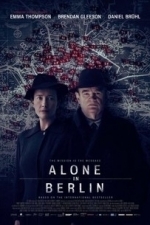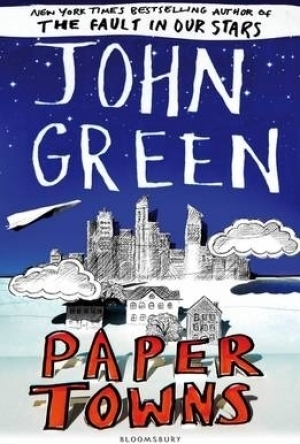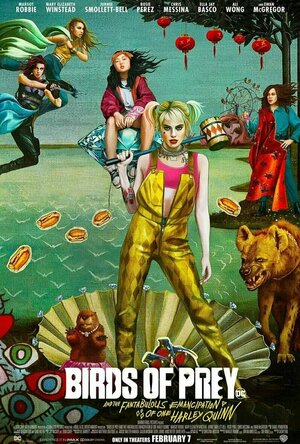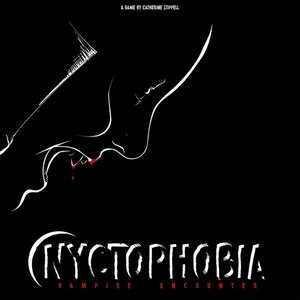
Guitar Jam Tracks: Acoustic Blues - Free Scales App
Music and Education
App
"A truly useful practice tool." - Guitar World Essential App of 2012 - WIRED Magazine Top 25 Guitar...

Piikki: Receipt Scanner
Finance and Productivity
App
Piikki is an amazing receipt scanner app for your iPhone & iPad. +++ Scan your receipts using the...
Purple Phoenix Games (2266 KP) rated DiTiC in Tabletop Games
Oct 2, 2019
So my original thought was to try to open this preview with a dastardly abstract statement to truly emphasize how theming is irrelevant with some activities. Not quite having done that, DiTiC is an abstract strategy game of “tile placement and dice-pawn” movement. How does it play? Read on.
In DiTiC the winner is the first player to upgrade one of their dice from a smaller-valued die into a value of six. Bring out smaller value dice and move them around the “board” to combine with other dice and win the game!
DISCLAIMER: We were provided a review copy of this game for the purposes of this review. These are preview copy components, and I do not know if the final components will be similar or different, or if the Kickstarter campaign will alter or add anything through stretch goals. -T
To setup a game of DiTiC, each player chooses a color of dice and takes all dice into their hand. The tile with “DiTiC START” on it is the, well, starting tile and is placed in the middle of the table. Roll off to see who goes first and you are ready to play!
On a turn a player may draw and place a tile or move one of their dice. Players start with zero dice on the board, so the first few turns will be drawing a tile from the bag and placing it on the board either side face-up. As you can see from the photos the tiles will have different colored (and shaped) corners. It’s when these corners complete an intersection of four tile corners that dice may enter the board. Depending on the color of the intersection’s majority control a die of said majority color comes into play on the value of the number of icons present. That’s a mouthful. So there are four corners to the intersection. If said intersection contains two red, a blue, and a black icon then red will place a die with value of two pips showing on that intersection. These dice may now be moved and combined with like-valued dice (with an exception). If a player has at least one die on the board when initiating this action, they may roll the action die after placement and complete any other actions the die result allows.
When a player decides instead to move, combine, or overtake a die, they simply move the die along the edge of a tile to the next closest intersection. Exception to movement: players can move all dice with a value of one BEFORE any other dice movement, and dice with value of one or two may move in any direction – even diagonally.
To combine/upgrade dice players will need to move one die into the same intersection as an equal-valued die in order to combine into a die of value +1. Example: a four die and a four die combine to make a five die. Exception to combinations: a value one die may combine with a value three die (remember the exception from the previous paragraph?) to create a value four die.
To overtake an opponent’s die, a player simply moves a superior die onto an occupied intersection. Typically, a die of larger value can overtake any die of smaller value. Exceptions: nothing may overtake a four or five, and only a five can overtake a three. Three-value dice seem to be the superheros of DiTiC.
So after many back-and-forth turns of placing tiles and rolling dice or moving/combining/overtaking dice the winner is crowned once they have upgraded any die into a value six die.
Components. Again, this is a prototype version of the game, so I will comment on what I can. I think the game looks very nice, even in this stage of production. The icons on the tiles are clear – and THANK YOU for considering the colorblind gamer community by making each icon different by both color and art style. The dice are your typical d6 (and I do not know if there will be any changes made to these as a result of a successful campaign). The icons on the action die make sense and I really dig the laser-etched wooden design, and I kinda hope that detail makes it into the final product. But I prefer wooden dice to plastic every time. The game also came with a burlap bag to house and conceal the tiles, and coupled with the wooden dice makes a nice little natural organic combo. My only request for the final version of the game? Go crazy with the color scheme. Black, red, white, and blue are great colors, but fling out the purple and the gold and the orange and the aqua. But I’m no designer. It looks great as it is.
So like I said up top, I love abstracts. Surprisingly so. The more I play them the more I love them. And this game definitely adds to my love of the genre. The rules are kinda wacky, and the dice of different values each can do their own thing, and I think that’s really interesting. It’s not simply a game of moving big dice around eating all the little dice. I mean, you CAN do that, but you will not advance your own strategies. But there is an amount of take that in this game, from the action dice to the tile placement to the overtaking of dice, that will really appeal to lots of people. It’s not a big game, but it looks great on the table, and plays really well once you have immersed yourself in the rules. I really believe that the more I play it the more I will fall in love with it. In fact, as I type this I want to go home and play it right now. And that’s a mark of a good, if not great, game, isn’t it?
If you like abstract strategy games and have a little room for this small game in your collection (or better, MAKE some room for it) then you should definitely consider backing it on Kickstarter, or (depending on when you read this) picking it up at your FLGS.

FineScanner PDF Scanner + OCR
Business and Productivity
App
FineScanner turns your mobile device into a powerful all-purpose mobile scanner to quickly capture...
Bob Mann (459 KP) rated Alone in Berlin (2017) in Movies
Sep 29, 2021
After losing their only son in the French campaign, Berliners Otto (Brendan Gleeson,”Harry Potter and the Goblet of Fire”) and Anna (Emma Thompson, “Saving Mr Banks“) turn against the regime and in repeated acts of rebellion Otto laboriously hand writes subversive postcards to leave in office blocks around Berlin.
Resistance is futile. Otto (Brendan Gleeson) and Anna (Emma Thompson) out on a new mission.
Out to catch him is local police investigator Escherich (Daniel Brühl) but in an age before CCTV that’s no easy task and with increasing SS pressure the stakes for Escherich steadily increase. For Otto and Anna, the stress is there but both are resigned to their fate: with their son stolen from them for an unjust cause they are an island of indifference in an unholy land. Both are ‘alone in Berlin’.
Daniel Brühl as police detective Escherich getting more than he bargained for from the SS.
After 70 years it still chills the blood to see German locations decked out in Nazi regalia, but one of the joys of this film is this rendering of life in wartime Berlin: starting with jubilation at German progress prior to D-Day and turning to despair and genuine danger as the tide turns towards 1945. In a pretty bleak film there are touches of black comedy now and then: Otto’s carpentry company is being encouraged “by the Fuhrer” to double and triple their output… of coffins.
A (very clean) Berlin, decked out with Nazi regalia.
More joy comes from the star turns of Gleeson and Thompson, both of who deliver on their emotionally challenging roles. Gleeson in particular makes a very believable German with a sour demeanor and a steely determination. But the star acting turn for me goes to the wonderful Daniel Brühl (“Rush“) as the tormented police detective, bullied into an ethical corner by the SS. The finale of the film – whilst not seeming quite believable – makes for a nicely unexpected twist.
The Nazi Womens’ League out on another fund-raising sweep, providing Thompson with one of her best scenes in the film with an Oberführer’s wife.
Based on a novel by Hans Fallada, the lead writing credits for the piece are shared between Achim von Borries and the director Vincent Perez – in a rare directorial outing for the Swiss actor. The script exudes a melancholic gloom and at times expresses beautifully both the grief and love shared by this older couple. But some of the dialogue needs more work and we don’t see enough of Thompson in the early part of the film where her motivations should be being developed. This rather comes down to a lack of focus by the director. While the primary story of the card distribution is slight, it is compelling and a detour into a sub-story about an old Jewish lodger living upstairs is unnecessary and detracts from the overall story arc. I would have far preferred if the running time had been a tight 90 minutes just focused on Otto’s mission. One final comment on the script: did I mishear that Anna claimed to have a 6 year old child during an air raid scene? I know Emma Thompson looks great for her age, but….
Otto and Elise Hampel – the real life characters on which the film’s Otto and Anna Quangel were based.
I can’t finish this without commending the beautiful piano score of Alexandre Desplat. From the first note I knew it was him – he has such a characteristic style – and his clever use of the score complements the film exquisitely. “Small” films like this tend to rather disappear into the woodwork for Oscar consideration, but here’s a soundtrack that I think should be considered: (but what do I know… when “Nocturnal Animals” wasn’t even nominated in one of the Oscar crimes of the century!).
In summary, I found this a thoughtful and thought-provoking film, that – despite some of the mean reviews I’ve seen – I thought was well crafted and with excellent production design by Jean-Vincent Puzos (“Amour”). It will be particularly appreciated by older audiences looking for an untold story from the war, and by all lovers of fine acting performances by the three leads.
Hazel (1853 KP) rated Paper Towns in Books
May 30, 2017
Set in Orlando, Florida, Paper Towns is narrated by eighteen-year-old Quentin Jacobson (often referred to as Q). It begins with a flash back to when he and next door neighbour, Margo Roth Spiegelman, were nine and discovered a dead body in the park. It is here that the differences in character are pointed out: “As I took those two steps back, Margo took two equally small and quiet steps forward.” Q is an anxious boy, whereas Margo comes across as very confident.
Despite their childhood relationship, for the main bulk of the story Q and Margo have grown apart. They belong to different social circles: Margo to the popular crowd and Q with the gamers, band members and social outcasts. But things take a turn when one night Margo climbs through Q’s bedroom window and insists he accompany her on a nighttime adventure, going around righting wrongs and wronging rights.
But the next day Margo runs away telling no one where she is going, except it appears that she has left clues to her whereabouts. Clues only intended for Q to discover. With the help of his prom-obsessed friend, Ben; Radar, the guy whose parents own the world’s largest collection of black Santas (seriously, where does Green come up with this stuff?); and Lacey, Margo’s best friend and Ben’s soon to be girlfriend; Q struggles to understand the clues and uncover Margo’s hiding place.
To begin with it is exciting to read about Q and his friends unscrambling the hidden messages but as the story goes on and Margo is yet to be found a sense of dread creeps up on us and Q begins to think the worst.
The final section, however, is fast past and thrilling to read as the characters travel across states, with a rather short time limit, in Q’s mini van in a final attempt to find Margo. What will they find when they arrive? Will Margo still be there?
At first I was not sure that I would like this book. Chapter one is mostly about Quentin, Ben and Radar fooling around as boys do, but once everything kicks off with Margo it is really exciting. Similarly to The Fault in our Stars, Green has filled Paper Towns with clever metaphors with paper, string, balloons and grass being used to represent life. It is a very witty narrative containing lots of humour, yet also manages to convey important ideas about the way we see the world, and the people in it.
Paper Towns can be described as a contemporary, coming-of-age story. As mentioned already, Margo was portrayed as a confident girl whereas Quentin was the opposite. Despite Q stating “I wanted Margo’s disappearance to change me; but it hasn’t, not really” I think Green has shown major character developments, and possibly even role reversals. Q may never completely get rid of his anxieties and does not totally become a different person, but he does gain more confidence as he is forced out of his comfort zone, and his perception of other people also begins to alter. Margo on the other hand may not be all that she seems. The real Margo may in fact be a quiet, rather lost teen in a world she feels trapped in. I think this story and Q’s development has the potential to inspire others of similar ages and make all readers question things about themselves.
Overall, an exceptionally good read.
Bob Mann (459 KP) rated Birds of Prey (And the Fantabulous Emancipation of One Harley Quinn) (2020) in Movies
Feb 15, 2020
Harley had spent years building up a catalog of enemies in Gotham, with no-one daring to lift a finger for fear of “the big J’s” retribution. With that now a thing of the past, the streets are no longer safe for Harley. Whereas most characters have a reason to want to kill Harley, mid-level gangster Roman Sionis (Ewan McGregor) has a list as long as his arm (a blurred list that will probably make freeze-framing of the blu-ray entertaining!). Roman, who has a penchant for having his right-hand man Victor (Chris Messina) de-glove his victim’s faces, has his heart set on obtaining a missing diamond that (McGuffin-alert) is engraved with account details to $billions.
Through a convoluted and messy plot, Harley meets various ‘birds of prey’ who are either friend or foe: notably young pickpocket Cassandra (Ella Jay Basco); cop Renée Montoya (Rosie Perez); the “Crossbow Killer” (Mary Elizabeth Winstead); and the “Black Canary” (Jurnee Smollett-Bell), who you don’t want to let near your best glasses.
As you might expect from your knowledge of Harley Quinn’s character, the movie is bat-shit crazy, with periodic breaking of the 4th wall; much acrobatic kick-boxing; and some random dream sequences….. Robbie as Marilyn is particularly entertaining, although at times (the ‘egg sandwich’ sequence in particular) the gurning made me muse to myself about just what a good film “I, Tonya” was.
It all comes across as something of a “Deadpool” sequel. Actually, I’d more describe it as “Deadpool-lite” since it’s not powered here by the charisma of Ryan Reynolds. However, I did find myself quite enjoying the first reel of the movie.
Unfortunately, it didn’t last.
It all just becomes incredibly tiresome. Although Margot Robbie is very good in the role, Harley’s incessant squawking just gets annoying.
Also in this battle of men vs women, the women always win and are (mostly) completely unscathed. In one particular scene there are 5 or 6 burly men taking on Harley: clearly she whips their sorry asses in improbable fashion. What? Only one at a time guys?
If you were confused by the timeline of “Little Women“, this will blow your mind! It makes Greta Gerwig‘s masterpiece look as linear as “News at Ten”! It’s really difficult to follow at times as the timeline flashes forwards and backwards and sideways at random!
Also confusing (for me anyway… did I have a nap?) was the finale. There’s something to do with a ring which made NO SENSE to me at all? Am I alone in that?
Ewan MacGregor has fun with his role as the gay (I assume?) gangster, but it all turns cartoonish at times. But perhaps, that’s the point? However while the violence in “Deadpool” was cartoonishly funny (as in Tom and Jerry) the violence here is decidedly of the vicious and unpleasant variety, with a vindictive edge. It makes you not particularly like any of the movie’s characters.
The movie is written by Christina Hodson, who is slated to write too more upcoming superhero films: “The Flash” and “Batgirl”. The director is Chinese director Cathy Yan in only her second directorial feature.
Summary: It’s loud and brash and at 109 minutes it overstays its welcome by about 20 minutes. Less would have been more. It’s somewhat better than “Suicide Squad” (which I unfathomably seem to have given 2.5 stars to), but it’s still a movie that I will struggle to remember in a month’s time.
(For the full graphical review, check out One Mann's Movies here - https://bob-the-movie-man.com/2020/02/15/one-manns-movies-film-review-birds-of-prey-and-the-fantabulous-emancipation-of-one-harley-quinn-2020/

FineScanner PRO - PDF Scanner
Business and Productivity
App
FineScanner turns your mobile device into a powerful all-purpose mobile scanner to quickly capture...
Purple Phoenix Games (2266 KP) rated Nyctophobia: Vampire Encounter in Tabletop Games
Jun 12, 2019
DISCLAIMER: There are technically 2 versions of this game – the OG version and the Vampire version. Thematically, they may be different, but mechanically and gameplay-wise, they’re the same! For the purposes of this review, we will be playing the Vampire Encounter version. -L
A lighthearted trip to the woods has taken a startling turn when you and your friends come across a Vampire! And to make things worse, the Vampire has managed to lure one of your buddies deep into the woods with him! You can’t just turn tail and run – you’ve gotta save your friend! The sun has set, though, and the woods are way more ominous than you thought. You and your friends must cooperate to carefully and quietly navigate in total darkness to avoid disclosing your position to the Vampire while searching for your friend. Will you manage to not only find your buddy, but make it back to the car for your getaway? Or will the Vampire manage to pick you all off, one by one, as he creeps around in the darkness waiting for the opportunity to pounce?
Nyctophobia: Vampire Encounter is a semi-cooperative 1-vs-All memory game with a twist – all players (except for the Vampire player) must wear black-out glasses and cannot see the board. All turns and movement are taken based on feel. You ARE in the dark woods after all – it’s not like you can see your surroundings. Basically how it works is that the Vampire player kind of acts as a GM for the game. They can see the board, and help guide the players’ hands to their pieces and move the player pieces as requested. The players are blind and must rely on feeling their way around the board (avoiding trees and the Vampire!) and communicating the perceived layout to their comrades. The Vampire player then sneaks around the board, silently trying to corner the other players and abduct them. Each player gets a special ability to use on their turns, and there’s a small combat element involved if a player ever runs into the Vampire. The goal of the game, for regular players, is to work with your friends to find the kidnapped NPC (represented by a cardboard standee) and get back to the car to escape. The goal of the game for the Vampire player is to pick off all other players until none remain.
I think this is a super neat game. It’s pretty unique and it’s fun to play! You’re trying to cooperate with your friends to create a strategy for a board that you can’t see. It’s definitely a challenge, but it’s presented in such a novel way that makes it enjoyable. The overall atmosphere of the game is great. The nerves and pressure can really get to the players as they are (quite literally) flailing around in the dark. The Vampire player can have a lot of fun as the GM – do you taunt your players and make them second-guess every move, or do you lay low and stay quiet until juuuust the right moment? Nyctophobia feels like more than just a game while you’re playing, and that is what makes it so exciting.
The only real issue I’ve run into with this game has to do with the components themselves. The board is an 8×8 grid, with the layout set up in secret by the Vampire player. On a regular player turn, you can feel up to 1 space in each adjacent direction to your current location. The only issue is that sometimes, unless the player is diligent, they could accidentally (or purposefully?) feel too many spaces than are allowed – either diagonally or 2 or more spaces away, for example. The way I’ve come up with to alleviate this issue is to have players use only 1 finger when interacting with their piece/the board. That way there can be no extra feeling. And I also, as the Vampire player, will move player pieces for them – the player tells me in which direction to move and I move the piece before guiding their hand back. Maybe if the board were a little larger, this problem would be eliminated? I’m really not sure, but the method I’ve come up with to combat it has worked well so far!
Overall, I enjoy Nyctophobia. It’s a neat game with a unique mechanical aspect and fun player interactions. Is it my favorite game to play? No. But it’s one that I like breaking out for newer gamers and for some lighthearted fun! If you haven’t done so already, give Nyctophobia a try because it’s a refreshingly new take on the modern board game. Purple Phoenix Games gives it a haunting 15 / 18.
https://purplephoenixgames.wordpress.com/2019/05/14/nyctophobia-review/

Snaptee - Custom Tshirt
Shopping and Lifestyle
App
Snap your masterpiece and we make & ship it as a tee! Snaptee is the first mobile app in the world...
